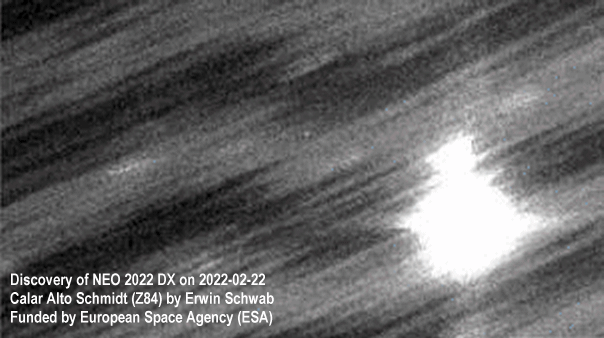Discovery of the near-Earth asteroid 2022 DX using the Schmidt Telescope at Calar Alto, Spain
On 2022-02-22 Erwin Schwab selected a search field about 20 degree eastern from opposition point on the ecliptic plane. Analyzing with the software Tycho Tracker an unknown fast moving object could be detected. The object immediately was added as ScMi503 (the discoverer’s reported designation) to the Near-Earth-Object (NEO) Confirmation Page and follow-up measurements were done by other observatories worldwide. The discovery was published in the Minor Planet Electronic Circular [1].
The Amor Type NEO has a size of about 10 meters and an earthlike orbit with an eccentricity of ~0.1, inclination ~0.2° and perihelion distance ~1.01 au. What makes it interesting is its motion with respect to the Earth, which offers the possibility to explore non-gravitational forces like the pressure of solar radiation acting on its surface, proposed in the Newsletter of the European Space Agengy (ESA) [2].
The used telescope is a Schmidt-Type-Reflector with an aperture of 0.8 meter and mirror diameter of 1.2 meter, which was built in 1954 for the Sternwarte Hamburg-Bergedorf by Zeiss Jena, Germany. 2022 DX is the first NEO discovered with this telescope since it has been shipped in 1975 to Calar Alto, Spain. When it was located at Hamburg-Bergedorf, the NEO (1865) Cerberus was discovered by L. Kohoutek on 1971-10-26 [3]. The operation has been funded by the ESA since 2016. The Head of ESA’s Planetary Defence Office was Detlef Koschny until 2022-02-28.
The Minimum Orbit Intersection Distances MOID of 2022 DX to the Earth is 0.016 au. The next similar close approach with minimum distance <0.02 au will not be before the year 2056 [4].

Animation of the discovery images on 2022-02-22. The „jumping“ object in the middle is NEO 2022 DX. The animation contains three stacked images. Each stack has an exposure time of 15x60s = 900s. It is a crop out of the total field of view. The bright star is GSC 0271.0775 with 9.7mag. © Schwab / ESA
[1] MPEC 2022-D46
[2] ESA Newsletter March 2022
[3] Cerberus @ MPC Database
[4] NEO.ESA-Database
